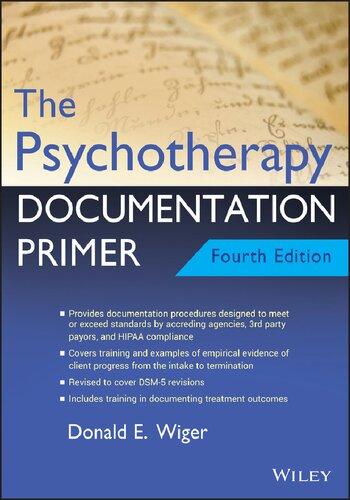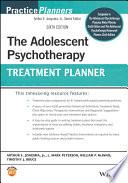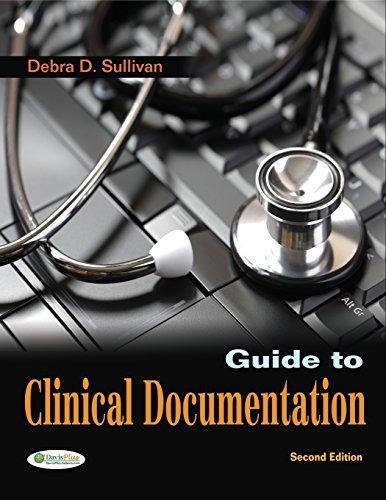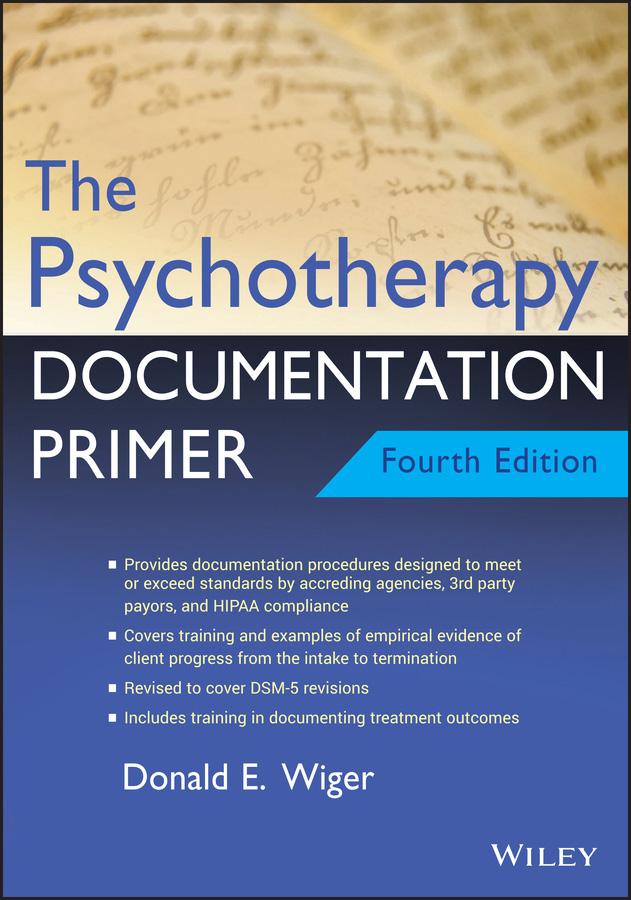The Psychotherapy Documentation Primer
Fourth Edition
Donald E Wiger
This edition first published 2021 © 2021, John Wiley & Sons, Inc.
4th Edition
All rights reserved. No part of this publication may be reproduced, stored in a retrieval system, or transmitted, in any form or by any means, electronic, mechanical, photocopying, recording or otherwise, except as permitted by law. Advice on how to obtain permission to reuse material from this title is available at http://www.wiley.com/go/permissions.
The right of Donald E. Wiger to be identified as the author of the editorial material in this work has been asserted in accordance with law.
Registered Office(s)
John Wiley & Sons, Inc., 111 River Street, Hoboken, NJ 07030, USA
Editorial Office
111 River Street, Hoboken, NJ 07030, USA
For details of our global editorial offices, customer services, and more information about Wiley products visit us at www.wiley.com.
Wiley also publishes its books in a variety of electronic formats and by print-on-demand. Some content that appears in standard print versions of this book may not be available in other formats.
Limit of Liability/Disclaimer of Warranty
While the publisher and authors have used their best efforts in preparing this work, they make no representations or warranties with respect to the accuracy or completeness of the contents of this work and specifically disclaim all warranties, including without limitation any implied warranties of merchantability or fitness for a particular purpose. No warranty may be created or extended by sales representatives, written sales materials or promotional statements for this work. The fact that an organization, website, or product is referred to in this work as a citation and/or potential source of further information does not mean that the publisher and authors endorse the information or services the organization, website, or product may provide or recommendations it may make. This work is sold with the understanding that the publisher is not engaged in rendering professional services. The advice and strategies contained herein may not be suitable for your situation. You should consult with a specialist where appropriate. Further, readers should be aware that websites listed in this work may have changed or disappeared between when this work was written and when it is read. Neither the publisher nor authors shall be liable for any loss of profit or any other commercial damages, including but not limited to special, incidental, consequential, or other damages.
Library of Congress Cataloging-in-Publication Data
Names: Wiger, Donald E., 1953- author.
Title: The psychotherapy documentation primer / Donald E. Wiger.
Description: Fourth edition. | Hoboken, NJ : John Wiley & Sons, Inc., [2021] | Includes bibliographical references and index.
Identifiers: LCCN 2020021962 (print) | LCCN 2020021963 (ebook) | ISBN 9781119709848 (paperback) | ISBN 9781119709923 (adobe pdf) | ISBN 9781119709930 (epub)
Subjects: LCSH: Psychiatric records. | Mental health services—Medical records. | Mental health services—Management.
Classification: LCC RC455.2.M38 W543 2021 (print) | LCC RC455.2.M38 (ebook) | DDC 616.890068—dc23
LC record available at https://lccn.loc.gov/2020021962
LC ebook record available at https://lccn.loc.gov/2020021963
Cover Design: Wiley
Cover Image: © AndrejaD/Getty Images
Set in 11/14pt PalatinoLTStd by SPi Global, Chennai, India
Preface
The Psychotherapy Documentation Primer is designed to teach documental skills for the course of psychotherapy from the initial interview to the discharge. The major revisions from the previous edition are due to changes from the Diagnostic and Statistical Manual of Mental Disorders (DSM)-IV-TR to the DSM-5 and more safeguards from potential procedural errors and omissions. An appendix on documenting suicidality has also been added.
The readership is intended for both students and professionals in the mental health field. Several graduate schools have incorporated this text in courses in which students learn to document clear evidence validating a diagnosis, effects of psychotherapy, treatment planning, and outcomes. Several experienced mental health professionals have written that the training has been quite helpful learning documentation techniques in which they had never been taught. Graduate training in mental health covers a broad education in several areas of psychology, psychotherapy, and other subjects related to the helping professions, but all too often, it does not provide detailed training in documentation techniques.
The documentation principles discussed in this text are especially helpful in satisfying the often rigid requirements of third parties, such as insurance companies and regulating agencies. In addition, the same documentation requirements satisfy what is typically required by mental health licensing boards.
Documentation, on the surface, appears to be a fairly dry subject. However, those who learn empirical and succinct documentation techniques find that the time they spend on this task reduces the time devoted to paperwork. Documentation is much more than basic “paperwork.” It provides clear evidence of the effects of mental health treatment. One does not have to be in the field very long until they experience an audit in which the only evidence available is what is documented. Documentation skills are an extremely important aspect of being a therapist.
The first edition covered documentation in the basic areas of clinical service. It was well received primarily because there wasn’t much published
on this topic. The second edition was published shortly after several Health Insurance Portability and Accountability Act (HIPAA) procedures were necessary to document; additional examples were provided. The third edition provided the same basic paradigms of documentation as the previous editions, with two additional chapters: (a) The Art and Science of Psychological Assessment and Treatment, and (b) Ethical Considerations in Documentation. The current edition incorporates diagnostic criteria of the DSM-5 and adds a chapter on documenting clinical outcomes and an additional appendix on documenting suicidality.
Donald E. Wiger
How This Book Came Into Being:
A Lesson in Making a Really Bad Negative Into a Really Good Positive
In 1991, I started a solo mental health practice with no clients, very little money, no office furniture, and no formal business training. However, I had a surplus of enthusiasm and dedication. I found a three-room office suite that had been vacant for over a year, so I figured that I could get a fairly good deal on the rent. The sympathetic, but also hungry landlord and I worked out a deal in which I wouldn’t have to pay rent for the first few months. He had nothing to lose because there had been no renters for over a year. He was glad just to have a renter. The furniture for the office came from my home. “Open for business!”
I did not take with me any of my clients whom I had seen from my former employer. I considered that to be an unethical practice. Instead, I transitioned them to other therapists when I left the practice. Of course, there can be exceptions to this rule, but be careful in such cases. I have seen too many therapists start their own practices by taking their clients with them from another agency. Over the years, I have witnessed many ill feelings between employers and ex-employees who “took their clients” with them, often without notice! This can cause much financial havoc for a clinic that has spent an incredible amount of time, money, and effort to build their practice. Bottom line: Cover such concerns in an initial contract with the employee or contractor. Be sure to use an attorney with plenty of expertise in this area. A relatively small investment up front could save your practice and reputation in the future. It can be difficult to have balance between being both in business and being in the helping profession.
To get started, I spent the remainder of my savings and much time establishing a counseling practice by scheduling talks with different groups, sending out mailers to several organizations, and letting other mental health professionals, with whom I had dealt previously, know that I had started a private practice. Many referrals came from other therapists who had a full
case load, in which they were glad to have a place to send people in need of services. Even my previous employer sent referrals my way.
Fortunately, growth took place quickly, and within the first year there were two additional full-time employees. The rate of growth skyrocketed because we incorporated progressive, but ethical business principles and emphasized customer service. Now we could afford nice furniture at home and at the office!
Unfortunately, even though our clinic was on the right track, our quick growth caught the eye of an insurance auditor. Our rather sudden volume of business led to high payments from Medicaid. Because the amount of billing skyrocketed from nothing to quite high in a few years, we were a red flag for an audit. When I received notice of an audit I wasn’t worried because we had records for every client and most likely underbilled rather than overbilled. So, a few weeks later, when the auditors showed up for their scheduled review, we were naively proud to show them that there were indeed their requested intake notes, treatment plans, and progress notes. I had written them the same way in which I was trained, so they must be pretty good!
The finding that complete records existed for every client and the rapid growth of the clinic was never mentioned as a positive by the auditors. We weren’t sure what they were attempting to find in our client records. The auditors copied multiple files and informed us that we would hear from them in about a month. Because they gave us no immediate feedback, we weren’t sure whether when they returned we would receive accolades or reprimands. But, we were quite confident that all was well.
For the next month, we did business as usual and didn’t think much about the audit. However, when they showed up for the feedback session, our lives soon changed. The auditors informed us that there were no financial improprieties, and there were no records missing. We had not billed for any dates of service in which there were no records and we had not overbilled for any procedures. So far . . . so good. But, then they opened their briefcases with seemingly hundreds of progress notes in which they said were “not in compliance.” My initial thoughts were, “not in compliance with what?” I was not taught a specific way to write progress notes in my graduate training, my internship, or my previous employment. I simply wrote down what we did in the session, just like at my previous job. But, they had never been audited! My problem was that I didn’t know what I didn’t know, which is commonly called “ignorance.” The old saying, “Ignorance of the law is no excuse” was now staring me in the face. I soon learned that other old adage, “Ignorance is bliss,” is not true.
The auditors kindly and respectfully explained that our progress notes stunk. Their point was that just because services took place, it doesn’t mean
that there is documented evidence that psychotherapy was necessary. They unsympathetically admonished me that psychotherapy records must document medical necessity. I had never heard of this term. It sounded like something someone would say in a medical office, not a counseling clinic. I thought to myself, “Medical necessity: We don’t provide medical services.” They went on to say that even though the assessments adequately explained the clients’ diagnoses, the progress notes did not recurrently confirm the diagnosis, reflect the effects of treatment, follow a specific measurable treatment plan, and need for continued treatment. My progress notes merely documented that treatment took place with some comments of what took place in the sessions. This was not enough.
They explained to me that the documented content of each session must match the goals and objectives written in the treatment plan. I had never heard of treatment plan goals and objectives the way in which they viewed them. Their main point was that my progress notes for every session did not clearly describe ongoing symptoms and impairments that should be listed in the intake notes and treatment plan. That is, every progress note should validate the current need for services and the services performed must be appropriate for the client’s problem areas. Even if a client is severely impaired mentally, if it is not documented in every progress note, there is no evidence for the need for psychotherapy. They repeatedly emphasized, “If it isn’t written down it doesn’t exist.” I wasn’t taught this in graduate school, nor in my initial employment.
I was told that I must pay back Medicaid the amount that I was paid for every progress note that did not meet this criterion. Although our treatment was appropriate and our clients’ outcomes were positive, our progress notes did not specifically address medical necessity. Even if services were medically necessary, if it wasn’t clearly documented, it didn’t matter to them.
Our documentation covered the contents of the sessions only. Bottom line: We provided documentation; but it was the wrong documentation. Perhaps we should have spent more time reading their bulky manual. I was convinced that we provided life-changing mental health services, but the documentation didn’t provide the evidence the auditors required. We had done nothing clinically, morally, or ethically wrong, but documentation is not about such skills; it is about supplying empirical evidence. Being a good therapist was not enough. What surprised me even more was that they didn’t ask for a payback for only the records that they had audited. They stated that because they audited one quarter of the records that I would have to pay back four times the amount of records that they had deemed not fitting their standards. Ouch!
This lack of appropriate documentation cost me several thousand dollars in paybacks to Medicaid. Fortunately, they put me on a payment plan;
otherwise, we would have gone out of business. At the time the effects of this audit seemed like the worst thing that could have happened to me. I had no one to blame but myself. I couldn’t tell the auditors that it wasn’t my fault because no one had taught me how to appropriately document psychotherapy; because as a mental health professional it was my responsibility to be accountable for learning the procedures expected from me.
What surprised me, even more, was that the auditors weren’t mental health professionals. They were trained in clerical areas. Although it took a while for me to make the connection, I eventually woke up to realize that if people not even trained in our profession can learn mental health documentation, I certainly had no excuses. This insight did not take place overnight!
The lessons learned from the audit inspired me to learn everything I could about documentation of mental health services. I studied information available from accreditation agencies, provider manuals from insurance companies, journal articles, and a few texts that existed at the time. With this information I revised our clinical forms to make sure that the information obtained accurately covered what was required. After sharing this information with colleagues, I was asked to present local seminars. This eventually led to presenting this material in several seminars nationally, teaching documentation skills. Before I knew it, my forms were published. The forms book is currently in its fourth edition (Wiger, 2010), and I’m working on the next edition. The auditors clearly did me a favor!
Now I’m glad that my clinic was audited. It changed my life! A negative experience transformed into something quite positive. Now, when I hear fellow clinicians complain about auditors and insurance companies, I don’t necessarily agree with them.
I have learned that when either an evaluation or therapy is being conducted, with a “documentation frame of mind,” the treatment is much more on target. It keeps me from getting off track with clients. It helps keep the intervention focused, in which time is not wasted time with the client. I have heard too many clients complain that, in their previous counseling, they did too much chit-chat and not enough therapy. Oftentimes, they did not even know that there was a treatment plan.
Of course, this is not to say that psychotherapy must be rigid and leave out the “human factor.” Certainly, establishing rapport with the client is both helpful and necessary, but it is a means to an end. For therapy to truly be effective, it must progress beyond therapist–client relationship. Or, to put it in baseball terms, getting to first base is a great first step, but if no further progress takes place, it isn’t helpful in the long run. Too many clients state that they go to counseling because it helps them feel good during the session, but when they go home, nothing changes. But, it does not lead to effective change
between sessions. Counseling is not about being someone’s shoulder to cry on. It is a growth process, designed for the client to eventually rely less and less on the therapist. The book teaches documentation techniques for the full course of therapy. It does not teach therapeutic techniques. Psychotherapy or counseling is an entirely different set of skills related to the therapist’s beliefs, personality, training, skill level, and what works for a specific client. Psychotherapy training offers a wide array of theories and techniques from which to choose. Each have their own merits. Documentation is atheoretical. It consists of no more than providing written evidence of the course of counseling.
CHAPTER 1
Introduction
Documentation of all aspects of mental health treatment is crucial in this age of accountability. It is the only evidence demonstrating the need and effects of treatment. Simply stating that a client has a certain diagnosis or claiming that therapy has been helpful to the client is an opinion but not evidence. Empirical evidence demonstrating that treatment was necessary and effective is essential. It is possible, and even compulsory, to document the outcomes of psychotherapy in objective, measurable terms without mechanizing or dehumanizing the process.
The clinical skills employed in psychological treatment are unrelated to documentation skills. It is possible to be an excellent therapist but have poor documentation skills. And, vice versa, one can be quite adept in documentation but not very helpful as a therapist. Of course, the goal is to be proficient in each of these realms.
It is not the purpose of this text to teach a particular mode of therapy that is easily documented, but rather, it is to teach documentation methods and skills that are useful for any school of thought. Therefore, the focus of this text is not on the “how to’s” of mental health treatment, but on documenting the necessity, goals, and effects of therapy. If the examples used in the documentation training appear to reflect a particular school of thought, it is not intentional.
We are living in the age of both personal and professional accountability. In addition to mental health workers, professionals such as politicians, executives, clergy, educators, and people from most walks of life have increasing demands placed on them to demonstrate that they have practiced their profession effectively and ethically. Reading the newspaper or watching the news on just about any given day substantiates the point of widespread ethical concerns. Modern political debates have emphasized ethical issues as much as political issues. An increasing number of well-known public figures have
filled the headlines and court dockets by compromising their professional standards. Colleges, universities, and professional schools have increased their required ethics courses over the past several years. Most mental health licensing boards require ongoing ethics training as part of their mandatory continuing education. Insurance premiums for mental health professions are often discounted when they provide evidence that they have taken ongoing continuing education credits in ethics.
Standards of accountability in the mental health profession come from a number of sources. State boards such as psychiatry, nursing, psychology, social work, substance abuse, professional counselors, and marriage and family therapy, each have specific guidelines for licensees. Accrediting agencies such as the Commission of Accreditation for Rehabilitation Facilities (CARF) and The Joint Commission (TJC) and third-party payers such as insurance companies and managed care organizations maintain specific documentation requirements to ensure accountability.
Such regulations are designed to both increase clinical effectiveness and help curtail the rising costs of mental health services, which have skyrocketed over the years. Current standards of third-party payers hold that services must be medically necessary in order to be covered for payment. Both third-party payers and regulatory agencies impose strict requirements in which each step of the clinical process must be clearly documented. Therefore, providing appropriate documentation and communicating evidence of clients’ needs for services is crucial for a clinic’s financial and professional survival and growth. As an added bonus, many mental health professionals have commented that after they have learned sound documentation skills, their therapy became more on target rather than vague or unfocused.
Learning on-target documentation procedures is much more than simply meeting professional regulations or requirements for payment of services. Accurate recording procedures provide clear evidence of what takes place in mental health sessions. Without accurate documentation, it is not possible to evaluate therapeutic effectiveness because there is not a clear record of what took place in therapy. Sloppy clinical procedures are not only unfair to the client but can border on malpractice. During times such as a third-party audit or a clinical review, proper documentation validates course of the therapy. When sound documentation procedures are followed, a written record of treatment will be available for review of (a) validation of the correct diagnosis, (b) the medical necessity of services, (c) therapeutic effectiveness, (d) appropriateness of services performed, (e) continuity of services, and (f) evaluation of therapeutic outcomes. The result is setting a high standard for mental health treatment.
In the past, third-party payers simply paid therapists when an insurance claim was made. Costs escalated, and thus managed care subsequently flourished. Today, third-party payers no longer blindly accept billing for any psychotherapy services. They require specific types of evidence demonstrating the client’s need for services and the therapeutic effectiveness in order to pay for the treatment. Without knowing proper documentation procedures and how to present a case on paper, the therapist is vulnerable to appearing to be “out of compliance” or providing “unnecessary services” even if the treatment is exceptional. If it isn’t written down, it doesn’t exist.
Many therapists have claimed that they were unaware that most thirdparty payers do not cover counseling that is intended solely for “personal growth,” rather than treating psychopathology. This is not to say that counseling for personal growth is not helpful, but it is typically not covered by insurance. Thus, it is usually an out-of-pocket expense. Such counseling likely fits under the category of the services a life coach offers. Please be aware that insurance companies do not pay for services without adequate documentation and a definite mental health diagnosis and related impairments. It can be quite tempting to assign a diagnosis to a client, whose symptoms do not meet the Diagnostic and Statistical Manual of Mental Disorders (DSM)-5 criteria for the diagnosis, in order to receive payment. Avoid this practice at all costs. Your reputation is on the line! Always explain to each client both the benefits and risks of having a record of mental health treatment as in Box 1.1.
There are certainly other risks to clients when receiving mental health treatment. Most of them are unfair to the client, who simply wants to get better. A few of these risks include the following:
1. Being labeled as having a mental illness can lead to stereotypes by both the client and others involved in the client’s life.
2. Poor therapy can lead to a decline in the client’s condition or a feeling that there is no hope. I have seen too many clients who apply for disability benefits when they are convinced that they will never get better because their previous counseling did not help, thus believing that they will never improve.
3. Some types of counseling are inappropriate for certain clients. For example, if for some reason a client can attend only 10 sessions (e.g., insurance benefits restrictions, cost, other timing factors), and the client has a severe mental illness that requires long-term therapy, the effects of brief treatment could be harmful if not conducted properly. That is, there is only time to “open the can of worms” but no resolution.
Box 1.1 Realistic Example of the Benefits and Risks of Receiving Mental Health Treatment
For the past 5 years John Doe has been under an increasing amount of stress. He had been promoted on his job to a very stressful position that required being on call at work 24/7. Although he was doing well career-wise, the stress of his job took a toll on his mental health. Gradually, it affected his marriage and attendance at work. For relief, he spent increasingly more time at a local bar. He spent large amounts of money unwisely, leading to significant debt. He often came home intoxicated and would miss work the next day. Eventually he lost his marriage, children, and his job. He felt empty inside and became severely depressed. His parents convinced him to see a therapist and receive substance abuse treatment. In treatment, he was diagnosed with both Major Depressive Disorder and Alcohol Use Disorder. Over time, he recovered and was quite thankful for the treatment he received. His compliance with professional treatment was a life changer. He was overjoyed when he reunited with his wife and children. Without this necessary treatment, he likely would have gone into deeper depression and perhaps harder drugs. When he disclosed to potential employers that his lapses of employment were due to mental health and chemical dependency treatment, he soon realized that his history of both mental health treatment and substance abuse affected that type of employment available to him. He eventually found work but at a much lower level of responsibility and pay. Yes, there are both benefits and risks of receiving mental health treatment.
Although most mental health professionals are properly schooled in conducting psychotherapy, few receive any training in documenting the evidence of their treatment. It is not uncommon for therapists, new to the field, to become discouraged when exposed to “the other responsibility” of providing mental health treatment: documentation. However, when properly trained, therapists soon realize the benefits of documentation by not only becoming more confident in meeting third-party requirements but also becoming more aware of their client’s progresses and setbacks; they are also more proficient at staying on task. Learning documentation procedures is a win-win situation.
Documentation for psychotherapy is atheoretical. It does not follow a certain school of thought. It is presented as behavioral evidence, in observable and
measurable terms; that have nothing to do with behavioral therapy. The clinician may conduct psychotherapy from any effective type of treatment (e.g., cognitive, behavioral, dynamic, gestalt, rational-emotive, solutions focused, etc.). Managed care companies, along with other third-party payers and accrediting organizations, are open to this variation, provided that there is written evidence of the course of therapy, not just a narrative. The evidence is presented in terms of objective client behaviors, not opinions or speculation. Evidence of alleviation of specific client impairments, which are secondary to the mental health symptoms, is required. They question, “What improvements in mental health or behavioral functioning are taking place as the result of the present therapy?” It is our job to provide this evidence by means of written documentation throughout the treatment.
Regulatory agencies require that the same measuring stick is used to assess the effects of therapy regardless of the treatment modality employed. The current measurement standards in mental health require that clinical documentation be observable, measurable, and provide behavioral evidence of therapeutic progress.
Documentation begins at the first interview. The several documentation procedures conducted throughout therapy are interrelated. The information collected in the initial interview is necessary for writing the treatment plan. The treatment plan provides a guideline for the course of therapy, which is documented in the progress notes. Progress notes are necessary for writing a revised treatment plan. All of the information collected is needed in writing the discharge summary and assessing outcomes as outlined in Figure 1.1.
The documentation procedure examples provided in this text represent a course of treatment for a client with depression. In addition, Appendix A provides documentation examples for a client with Panic Disorder with Agoraphobia.
Initial
Ongoing During Course of Treatment
End
Diagnostic Interview
Treatment Plan
Progress Notes
Treatment Plan Revisions/Updates
Progress Notes
Discharge Summary
Figure 1.1 Course of documentation
Source: Reprinted with permission of John Wiley & Sons, Inc.
This text begins with teaching the rationale and examples of documentation for each step of the therapeutic process. In addition, it provides training as to what documentation is required for third-party payers and accreditation agencies.
HIGHLIGHTS OF CHAPTER 1
● Accurate and specific documentation procedures are necessary for ethical, professional, and financial reasons.
● Third-party payers and accrediting agencies are becoming more stringent in their required documentation procedures.
● The intake, treatment plan, progress notes, revised treatment plan, and discharge summary are interrelated. Although they are independent documents, they represent a continuous process in therapy and documentation.
● Each step in the counseling procedures has specific documentation procedures, if not followed, could be detrimental to the client, therapist, and the clinic. Likewise, all can benefit with appropriate procedures.
● Documentation procedures are atheoretical. They do not represent a form of treatment, but rather, they demonstrate the effects of treatment in objective, measurable terms.
QUESTIONS
1. In the medical model of documentation, the means by which a therapist documents therapy
a. depends on the theoretical school of thought.
b. is atheoretical.
c. is not important.
d. incorporates documenting impairments rather than strengths.
2. A current requirement by most third-party payers to cover mental health services is documenting
a. that personal growth will take place in therapy.
b. that a preexisting condition was not present.
c. proof of insurability.
d. medical necessity.
3. Client files that are audited by a third-party payer that not found to be compliant with documentation standards
a. typically leads to loss of licensure.
b. is a minor concern to most clinicians.
c. may be subject to repaying funds back to the third-party payer.
d. is a clear violation of confidentiality.
4. Typically, the evidence a third-party case manager uses to determine that the treatment plan has been followed is found
a. in the progress notes.
b. by interviewing the client.
c. through determining the number of sessions that have been conducted, to date.
d. in the initial summary report.
5. Why might counseling for the sole purpose of “personal growth” not be covered by an insurance company?
a. It isn’t necessarily medically necessary.
b. It does not have a DSM-5 diagnosis.
c. It is too vague of a concept.
d. all of these.
Answers: 1b, 2d, 3c, 4a, 5d
CHAPTER 2
The Art and Science of Psychological Assessment and Treatment
“There is no pretense that reason and reason alone, or that science and science alone, can prevail by themselves in any kind of human relationship, personal or therapeutic.”
(Mann, 1973, p. 48)
Mental health clients desire a treating professional who is knowlegable, caring, empathic, and able to help them work through issues. However, they do not want treatment from someone who fully “plays it by ear” or says whatever comes into mind. A high degree of professionalism and knowledge is expected. Otherwise, why would we need graduate training? On the other hand, clients do not desire working with a therapist who is so scientific or technical that the human element is lost. A combination of art and science is necessary in the delivery of mental health services (Walborn, 1996).
Mental health professionals vary tremendously in their views of how to accurately collect diagnostic information and conduct therapy. On one extreme we have those who believe and practice psychology based on their gut feelings, intuition, and their inner gift of helping others. The other extreme consists of a close adherence to a rigid scientific medical model. If one were to observe therapists from each of the two extremes it would seem as if they were in different professions. Most of us are somewhere in between, in which we rely on both the lessons of scientific research and our clinical acumen and insight.
The clinical practices in the field of psychology follow the same pendulum as other historical trends. Sometimes the pendulum swings toward hard science, but eventually, when it becomes too regimented; we miss the “good old days” and gradually return to the softer sciences and less empirical methods.
But, the further the pendulum swings, we realize that we need more empirical research for our practices, and the pendulum gradually reverses.
The following two sections discuss differences between practicing therapy as an art vs. science. Therapists are not “one or the other.” Each of us practice somewhere between the two poles. Thus, it is likely that you adhere to some aspects of each dimension.
THE PRACTICE OF MENTAL HEALTH AS AN ART
Many experienced and successful therapists view their clients as unique individuals; therefore, placing them into a diagnostic category would seem counterproductive and impersonal. They tend to reject any requirements of placing a diagnosis on a client because it provides no more than a label that serves little or no therapeutic purpose. They realize that the client’s concerns are likely multifaceted. Thus, assigning a label is viewed as pointless, unhelpful, and potentially detrimental to their clients.
The documentation of both the assessment and therapy generally consists of listing the client’s present feelings and noting insights gleaned by the client. This modality has been around for years and has a long history of success. In this model of a typical assessment, the therapist would not focus on empirically validating a diagnosis to fit outside criteria but rather attempt to soothe the client and provide hope and direction for the future. The initial assessment session is often mixed with a number of therapeutic interventions in which rapport develops. Focusing on the client’s immediate and longterm needs is crucial.
The greatest strengths the therapist has are being able to focus on the hereandnow, empathy, insight, instilling hope, and providing guidance and emotional support. They tend to be patient with clients and allow them to progress at their own rates. They often reject any thirdparty restrictions on the modality and number of sessions allowed for treatment.
For example, if a child is referred for problems with temper tantrums, the therapist could focus on the child’s feelings and attempt to discover why the child has tantrums (e.g., stress, pain, home conditions, getting one’s way, etc.). It would be important to develop a trusting relationship in order for the child to be able to gradually trust the therapist and his/her interventions. One of the primary goals of the therapist would be to discover the root cause of the tantrums and help the client work through these issues. An effective therapist would be skillful in human relationship skills to help the child become more positively effective.
THE PRACTICE OF MENTAL HEALTH AS A SCIENCE
Mental health counseling is also practiced from an empirical point of reference. Therefore, scientific principles are the primary modality of assessment and treatment. Human behavior is viewed as being subject to scientific methods in which people are viewed as fairly predictable if we knew enough about them. The causes of maladaptive behaviors can be understood if the appropriate information is collected. All behavior and emotion have a cause and an effect. To change behavior requires making modifications in the client’s external and/or internal environment.
A common paradigm for treatment is the ABC model (AntecedentsBehaviorConsequences). The antecedents are the events that take place that trigger the behavior. The consequences are the rewards or punishments received after the behavior takes place. The consequences might come from others, the physical environment, or viewed subjectively by the client. A behavior can be changed if either the antecedents and/or the consequences are altered. A behavior remains the same or escalates if the antecedents and consequences remain the same. For example, if a child receives attention only when acting out he/she will continue to act out as long as attention is received. Let us return to the child being evaluated for temper tantrums. The examiner, from a scientific perspective, would inquire about what takes place before the tantrums to determine what can be altered to avoid such situations; in addition, information would be gathered to determine the consequences for tantrumming in order to determine what rewards or punishments (intrinsic or extrinsic) could be increased to help prevent tantrums.
INTEGRATING THE ART AND SCIENCE OF MENTAL HEALTH
Few people practice at the extreme end of the art/science continuum (Figure 2.1). The various schools of thought vary significantly in their viewpoints. For example, radical behaviorism holds to a strict scientific viewpoint of practicing psychology, whereas humanistic and existential viewpoints fall on the art side of clinical practice. The cognitive/behavioral school of thought incorporates and integrates each stance. Most modern practitioners claim to be eclectic, picking and choosing what works best for them and their clients. Within each school of thought there is variation among practitioners. Therapy and documentation are two very different skills to learn. A therapist has a choice between multitudes of theoretical frameworks, or any combination. Therapy can range from an intuitive to a regimented approach. Walborn (1996) provides an excellent text, Process Variables, in which each of
The Range of Practice in Mental Health Treatment
Figure 2.1 The differences and overlap in the practice of psychology as an art vs. science from three theoretical points of view. The numbers used are for example only and are not based on specific published material.
the major therapies are compared and contrasted as to their effectiveness. The focus of the text is that the mode of therapy is not what leads to client change. Instead, Walborn (1996) lists four process variables, which, if they take place, no matter what type of therapy (art vs. science), client change will take place. These variables include (a) the therapeutic relationship, (b) cognitive insight and change, (c) emotions in therapy, and (d) client expectations. Walborn (1996) describes how even though the therapies might appear to be quite different; they each treat the various components of the process variables. Thus, it is not the therapies themselves that lead to client change, but transformation takes place from the common therapeutic processes they have in common. This is not to say that all therapies are the same. Although the various therapies hold different views of what is necessary for client change, the process variables that lead to client change are common between the therapies.
DOCUMENTATION IN THE LIGHT OF ART VS. SCIENCE
Therapists differ immensely as to what should take place in a counseling session. This difference allows clients to receive treatment in a manner that best suits their needs. Further, it allows therapists to practice the mode of therapy according to their particular school or schools of thought. However, documentation is not about psychological theories and does not follow a school of thought. Documentation is no more than the written evidence of objective
observations with supporting data. With good documentation, the client’s progresses and course of therapy can be fairly well understood by the client, therapist, and a third party. It can be especially helpful when a new therapist takes over the case. Otherwise, little is known and the new therapist, for the most part, starts over.
Documentation is used for several purposes including (a) objectively monitoring progresses and setbacks in treatment, (b) monitoring the effectiveness of current interventions, (c) working collaboratively with other professionals, and (d) audits from third parties such as those who pay for services, accreditation reviews, legal matters, and professional review boards. Very few therapists enjoy documentation; however, many therapists who have not done a good job of documenting have, unfortunately, realized its importance when their charts were audited.
No matter what you have chosen for the type of therapy you provide, if does not affect what third parties require for documentation. Documentation is atheoretical. It takes the same amount of time and effort to document if you conduct therapy as an art or science. However, when you learn what is expected in documentation, it can be surprising how little time it takes. Usually all or most of your documentation can be completed during the session, rather than time spent after the session. Little or no time is needed after the session for most types of documentation.
HIGHLIGHTS OF CHAPTER 2
● There is clearly no set or standardized means of conducting psychological services.
● Those who view psychotherapy as an art hold values such as gut feelings, intuition, and insight.
● Those who view conducting psychological services as a science hold values such as the scientific method, in which objective data are incorporated into treatment.
● Other schools of thought incorporate a combination of incorporating treatment as both an art and science.
● Although the various theoretical perspectives may seem to be diverse, they have common process variables in which their commonalities contribute to client change.
● No matter what therapeutic orientation a therapist follows, documentation is atheoretical, in which current standards require an empirical format.
QUESTIONS
1. Which of the following best represents a statement from someone who views psychotherapy as an art? “Today we worked on . . .
a. “. . . identifying why she feels rewarded by excessively washing her hands.”
b. “. . . expressing latent emotions.”
c. “. . . identifying what factors lead to outbursts at work.”
d. “. . . identifying rational behaviors.”
2. Which of the following treatment strategies would most likely be incorporated by someone from a scientific perspective of psychological treatment?
a. Dream interpretation
b. Psychiatric hospitalization
c. ABC model
d. Expressing empathy
3. According to this text, documentation
a. is atheoretical.
b. should correspond to the theoretical model used in treatment.
c. it important, thus it requires much of the therapist’s time.
d. All of these.
4. Process variable research
a. maximizes the differences between psychological therapies.
b. suggests that there are very different processes that take place in the various therapies.
c. suggests that documentation can be either written as an art or science.
d. integrate the similarities between psychological therapies.
5. Because the modes of psychotherapy vary tremendously, documentation of psychotherapy
a. also differs between them significantly.
b. must clearly represent the theoretical model used in treatment.
c. is useless because it violates the client’s right to privacy.
d. None of these.
Answers: 1b, 2c, 3a, 4d, 5d











